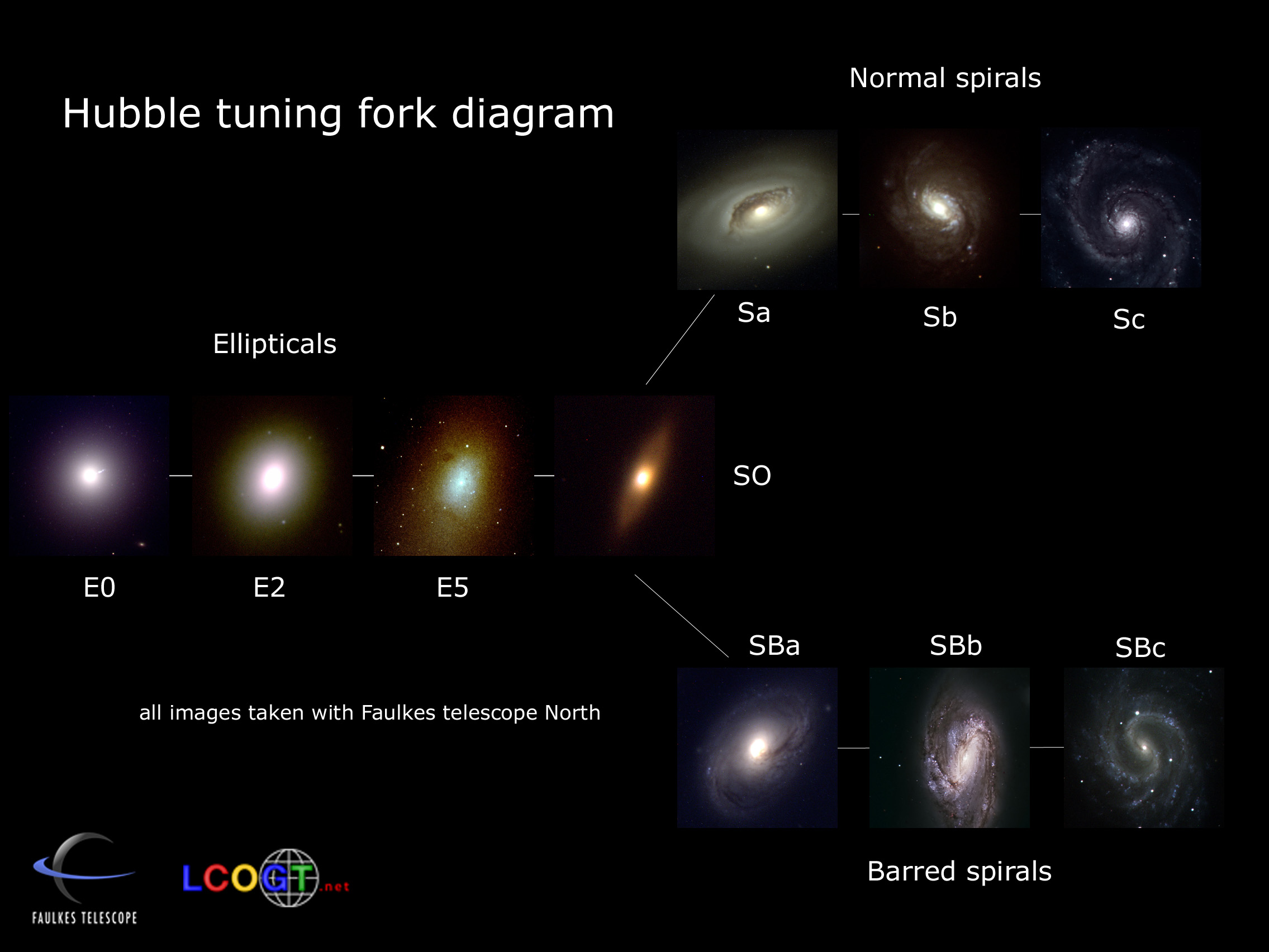|
|
 The Hubble tuning fork, illustrated with images taken by
the Faulkes Telescope North;
tuning fork image compiled by the Las Cumbres Observatory
Global Telescope Network. Not shown in this diagram are the irregular galaxies,
and the division of the S0 class into barred and unbarred. (This is a very large image: to see it in its full glory, do "View image" in your browser.)
The Hubble tuning fork, illustrated with images taken by
the Faulkes Telescope North;
tuning fork image compiled by the Las Cumbres Observatory
Global Telescope Network. Not shown in this diagram are the irregular galaxies,
and the division of the S0 class into barred and unbarred. (This is a very large image: to see it in its full glory, do "View image" in your browser.)
|
Summary of Lecture 8 – Other Galaxies
- Telescopic images of the night sky reveal many other galaxies:
- we can confirm that these are large, distant objects (not local nebulae)
by using standard candles – objects of known
intrinsic brightness;
- for relatively nearby galaxies, the best standard candle is a
certain type of variable star called a
Cepheid variable, whose luminosity can be
calculated from its period of variation;
- for more distant galaxies, other methods have to be worked out
[see PHY216 next year];
- Galaxies come in a number of different types:
- elliptical galaxies have a smooth, elliptical shape
with no obvious internal structure
- classified E0 to E6 depending on how elongated
they appear (E0 = circular, E6=very elongated)
- consist of old stars, like the Milky Way's bulge; little or no
gas to form new stars
- most rotate slowly or not at all, like the Milky Way's halo
- small, faint elliptical galaxies often occur as satellites of
large galaxies: they are called dwarf
ellipticals (dE) or, especially if very
small and faint, dwarf spheroidals (dSph)
- spiral galaxies have a bulge of old stars surrounded
by spiral arms of young stars (including massive blue main sequence
stars)
- classified Sa to Sc depending on the relative
brightness of the bulge (faintest in Sc) and how tightly
wound the arms are (loosest in Sc)
- the Milky Way is a typical large spiral galaxy, so for
properties of spirals see Lecture 7
- rate of new star formation increases from Sa to Sc
- as with the Milky Way, the spiral arms are embedded in a disc
(which tends not to show up on photographs since it is less bright)
- barred spiral galaxies resemble ordinary spirals,
but have a straight central bar through the bulge
- classified SBa to SBc in the same way as
ordinary spirals
- galaxies with an elongated bulge which is not as prominent as a
"real" bar are sometimes classed as SABa to SABc
- in barred spirals, spiral arms emerge from ends of bar
- lenticular or S0 galaxies resemble spiral galaxies,
but have no spiral arms (though they do have a disc)
- classified S0 (unbarred) or SB0 (barred)
- bulge and disc both made of old stars
- irregular galaxies have an amorphous
(Irr I) or disrupted (Irr II) structure
- generally have a very high proportion of young stars and
active star formation
- Irr I galaxies are small (perhaps "spirals" too small to develop
regular structure) and, like dwarf ellipticals, often seen as
satellites of larger galaxies
- Irr II galaxies appear to have suffered a catastrophic event
(collision or close encounter?)
This classification scheme was originated by Edwin Hubble and is generally
known as Hubble's tuning fork. The Milky Way is usually
classified as Sbc or SABbc, midway between Sb and Sc and weakly barred.
- Galaxies tend to occur in small groups or larger
clusters:
- the Milky Way belongs to the Local Group
- two giant spirals, the Andromeda Galaxy M31 (Sb)
and the Milky Way (Sbc)
- one small spiral, M33 (Sc)
- at least 30 irregular and dwarf elliptical galaxies, the largest
being the Large Magellanic Cloud, most of which are satellites of one of the two big spirals
- the nearest large cluster, the Virgo Cluster,
contains thousands of galaxies
- elliptical and lenticular galaxies are much more common in rich
clusters
- Almost all galaxies are moving away from us (their spectra are redshifted):
- the speed of recession (the amount of redshift) is proportional to the
distance from us [see later]
Web links
- The PowerPoint file for this lecture.
- Nick Strobel and Gene Smith both discuss galaxies; the Smith page has a very useful table summarising the properties of galaxies in different Hubble classes.
- The idea for the "real galaxies" Hubble tuning fork in the lecture came from this page by Ray White of the University of Alabama (and I pinched some of his images). His irregular and dE images seem to be dead links though. Gene Smith has a similar diagram, and there is a rather messier (no pun intended) version based on galaxies in the Messier catalogue here.
- Charles Messier compiled his catalogue of "fuzzy objects in the sky" to help him in searching for comets. Many Messier objects are galaxies. An excellent online guide to the Messier catalogue, with links to many images of galaxies, can be found at the SEDS site or its Munich mirror.
- Beautiful images of galaxies can also be found at The Anglo-Australian Observatory, ESO and the HST.
- A short self test for this lecture.
Go back to main page
Go on to Summary for Lecture 9
|
Hicks Building, Hounsfield Road, Sheffield S3 7RH, UK
|